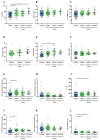Local and Systemic Alterations of the L-Arginine/Nitric Oxide Pathway in Sputum, Blood, and Urine of Pediatric Cystic Fibrosis Patients and Effects of Antibiotic Treatment
- PMID: 33255369
- PMCID: PMC7761143
- DOI: 10.3390/jcm9123802
Local and Systemic Alterations of the L-Arginine/Nitric Oxide Pathway in Sputum, Blood, and Urine of Pediatric Cystic Fibrosis Patients and Effects of Antibiotic Treatment
Abstract
Alterations in the L-arginine (Arg)/nitric oxide (NO) pathway have been reported in cystic fibrosis (CF; OMIM 219700) as the result of various factors including systemic and local inflammatory activity in the airways. The aim of the present study was to evaluate the Arg/NO metabolism in pediatric CF patients with special emphasis on lung impairment and antibiotic treatment. Seventy CF patients and 78 healthy controls were included in the study. CF patients (43% male, median age 11.8 years) showed moderately impaired lung functions (FEV1 90.5 ± 19.1% (mean ± SD); 21 (30%) had a chronic Pseudomonas aeruginosa (PSA) infection, and 24 (33%) had an acute exacerbation). Plasma, urinary, and sputum concentrations of the main Arg/NO metabolites, nitrate, nitrite, Arg, homoarginine (hArg), and asymmetric dimethylarginine (ADMA) were determined in pediatric CF patients and in healthy age-matched controls. Clinical parameters in CF patients included lung function and infection with PSA. Additionally, the Arg/NO pathway in sputum samples of five CF patients was analyzed before and after routine antibiotic therapy. CF patients with low fractionally exhaled NO (FENO) showed lower plasma Arg and nitrate concentrations. During acute exacerbation, sputum Arg and hArg levels were high and dropped after antibiotic treatment: Arg: pre-antibiotics: 4.14 nmol/25 mg sputum vs. post-antibiotics: 2.33 nmol/25 mg sputum, p = 0.008; hArg: pre-antibiotics: 0.042 nmol/25 mg sputum vs. post-antibiotics: 0.029 nmol/25 mg sputum, p = 0.035. The activated Arg/NO metabolism in stable CF patients may be a result of chronic inflammation. PSA infection did not play a major role regarding these differences. Exacerbation increased and antibiotic therapy decreased sputum Arg concentrations.
Keywords: Pseudomonas aeruginosa; antibiotics; cystic fibrosis; inflammation; nitric oxide.
Conflict of interest statement
The authors declare no conflict of interest.
Figures


Similar articles
-
Impaired Nitric Oxide Synthetase Activity in Primary Ciliary Dyskinesia-Data-Driven Hypothesis.J Clin Med. 2023 Sep 16;12(18):6010. doi: 10.3390/jcm12186010. J Clin Med. 2023. PMID: 37762950 Free PMC article.
-
Activated L-Arginine/Nitric Oxide Pathway in Pediatric Cystic Fibrosis and Its Association with Pancreatic Insufficiency, Liver Involvement and Nourishment: An Overview and New Results.J Clin Med. 2020 Jun 26;9(6):2012. doi: 10.3390/jcm9062012. J Clin Med. 2020. PMID: 32604946 Free PMC article.
-
Comprehensive analysis of the L-arginine/L-homoarginine/nitric oxide pathway in preterm neonates: potential roles for homoarginine and asymmetric dimethylarginine in foetal growth.Amino Acids. 2017 Apr;49(4):783-794. doi: 10.1007/s00726-017-2382-9. Epub 2017 Feb 4. Amino Acids. 2017. PMID: 28161799
-
Homoarginine in the shadow of asymmetric dimethylarginine: from nitric oxide to cardiovascular disease.Amino Acids. 2015 Sep;47(9):1741-50. doi: 10.1007/s00726-015-2017-y. Epub 2015 Jun 27. Amino Acids. 2015. PMID: 26123985 Review.
-
Pseudomonas aeruginosa chromosomal beta-lactamase in patients with cystic fibrosis and chronic lung infection. Mechanism of antibiotic resistance and target of the humoral immune response.APMIS Suppl. 2003;(116):1-47. APMIS Suppl. 2003. PMID: 14692154 Review.
Cited by
-
Metabolomic profiling of saliva from cystic fibrosis patients.Sci Rep. 2025 Jan 2;15(1):479. doi: 10.1038/s41598-024-84191-9. Sci Rep. 2025. PMID: 39747338 Free PMC article.
-
Impaired Nitric Oxide Synthetase Activity in Primary Ciliary Dyskinesia-Data-Driven Hypothesis.J Clin Med. 2023 Sep 16;12(18):6010. doi: 10.3390/jcm12186010. J Clin Med. 2023. PMID: 37762950 Free PMC article.
-
Short-Term Supplementation of Sodium Nitrate vs. Sodium Chloride Increases Homoarginine Synthesis in Young Men Independent of Exercise.Int J Mol Sci. 2022 Sep 13;23(18):10649. doi: 10.3390/ijms231810649. Int J Mol Sci. 2022. PMID: 36142560 Free PMC article. Clinical Trial.
-
Mucus Structure, Viscoelastic Properties, and Composition in Chronic Respiratory Diseases.Int J Mol Sci. 2024 Feb 5;25(3):1933. doi: 10.3390/ijms25031933. Int J Mol Sci. 2024. PMID: 38339210 Free PMC article. Review.
-
Metabolomic Biomarkers to Predict and Diagnose Cystic Fibrosis Pulmonary Exacerbations: A Systematic Review.Front Pediatr. 2022 May 31;10:896439. doi: 10.3389/fped.2022.896439. eCollection 2022. Front Pediatr. 2022. PMID: 35712620 Free PMC article.
References
-
- Fabris L., Fiorotto R., Spirli C., Cadamuro M., Mariotti V., Perugorria M.J., Banales J.M., Strazzabosco M. Pathobiology of inherited biliary diseases: A roadmap to understand acquired liver diseases. Nat. Rev. Gastroenterol. Hepatol. 2019;16:497–511. doi: 10.1038/s41575-019-0156-4. - DOI - PMC - PubMed
-
- Wakeman C.A., Moore J.L., Noto M.J., Zhang Y., Singleton M.D., Prentice B.M., Gilston B.A., Doster R.S., Gaddy J.A., Chazin W.J., et al. The innate immune protein calprotectin promotes Pseudomonas aeruginosa and Staphylococcus aureus interaction. Nat. Commun. 2016;7:11951. doi: 10.1038/ncomms11951. - DOI - PMC - PubMed
-
- Elborn S., Vallieres E. Cystic fibrosis gene mutations: Evaluation and assessment of disease severity. AGG. 2014;4:161. doi: 10.2147/AGG.S53768. - DOI
Grants and funding
LinkOut - more resources
Full Text Sources
Research Materials
Miscellaneous

